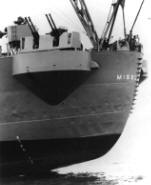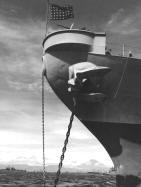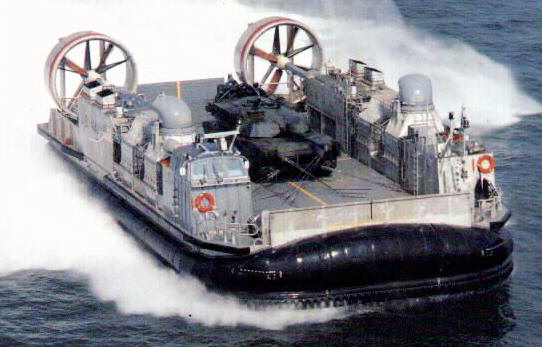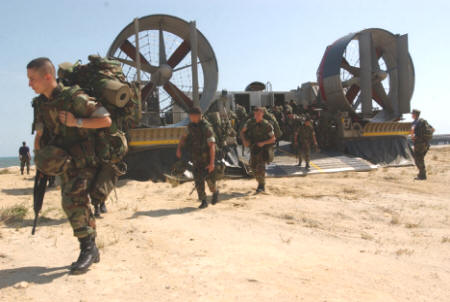Description
Air cushion craft for transporting, ship-to-shore and across the beach,
personnel, weapons, equipment, and cargo of the assault elements of the
Marine Air-Ground Task Force. |
| |
Features
The Landing Craft Air Cushion (LCAC) is a high-speed, over-the-beach
fully amphibious landing craft, capable of carrying a 60-75 ton payload.
It is used to transport the weapons systems, equipment, cargo and
personnel of the assault elements of the Marine Air-Ground Task Force
from ship to shore and across the beach. LCAC can carry heavy payloads,
such as an M-1 tank, at high speeds. The LCAC payload capability and
speed combine to significantly increase the ability of the Marine Ground
Element to reach the shore. Air cushion technology allows this vehicle
to reach more than 70 percent of the world's coastline, while only about
15 percent of that coastline is accessible by conventional landing
craft. |
| |
Background
Concept Design of the present day LCAC began in the early 1970s with the
full-scale Amphibious Assault Landing Craft (AALC) test vehicle. During
the advanced development stage, two prototypes where built. JEFF A was
designed and built by Aerojet General in California. JEFF B was designed
and built by Bell Aerospace in New Orleans, Louisiana. These two craft
confirmed the technical feasibility and operational capability that
ultimately led to the production of LCAC. JEFF B was selected as the
design basis for today’s LCAC.
The first LCAC was delivered to the Navy in 1984 and Initial Operational
Capability (IOC) was achieved in 1986. Approval for full production was
granted in 1987. After an initial 15-craft production competition
contract was awarded to each of two companies, Textron Marine and Land
Systems (TMLS) of New Orleans, La., and Avondale Gulfport Marine, TMLS
was selected to build the remaining craft. A total of ninety-one LCAC
have now been built. The final craft, LCAC 91, was delivered to the U.S.
Navy in 2001. This craft served as the basis for the Navy’s LCAC Service
Life Extension Program (SLEP). To date three operational craft have been
delivered to the Navy in the SLEP configuration.
LCAC first deployed in 1987 aboard USS Germantown (LSD 42). LCAC are
transported in and operate from all amphibious well deck ships including
LHA, LHD, LSD and LPD. The craft operates with a crew of five.
In addition to beach landing, LCAC provides personnel transport,
evacuation support, lane breaching, mine countermeasure operations, and
Marine and Special Warfare equipment delivery. |
| |
Program Status
All of the planned 91 craft have been delivered to the Navy. A Service
Life Extension Program (SLEP) is currently in progress to add service
life to the craft design life of 10 years, delaying the need to replace
these versatile craft. |
| |
Point Of Contact
Public Affairs Office
Naval Sea Systems Command
Washington, DC 20362 |
| |
General Characteristics,
LCAC 1
|
| Builder:
Textron Marine and Land Systems/Avondale Gulfport Marine. |
| Date Deployed:
1982. |
| Propulsion:
4- Allied-Signal TF-40B gas turbines (2 for propulsion/2 for lift);
16,000 hp sustained; 2- shrouded reversible pitch airscrews; 4-
double-entry fans, centrifugal or mixed flow (lift) / 4 – Vericor Power
Systems ETF-40B gas turbines with Full Authority Digital Engine Control
(FADEC) |
| Length: 87
feet 11 inches (26.4 meters). |
| Beam: 47 feet
(14.3 meters). |
| Displacement:
87.2 tons (88.60 metric tons) light; 170-182 tons (172.73 - 184.92
metric tons) full load. |
| Speed: 40+
knots (46+ mph; 74.08 kph) with full load. |
| Range: 200
miles at 40 kts with payload / 300 miles at 35 kts with payload. |
| Crew: Five. |
Load: 60 tons
/ 75 ton overload (54.43/68.04 tonnes)
Military lift: 24 troops or 1 MBT. |
| Armament: 2 -
12.7mm MGs. Gun mounts will support: M-2HB .50 cal machine gun; Mk-19
Mod3 40mm grenade launcher; M-60 machine gun. |
| Electronics:
Radars, Navigation: Marconi LN 66; I band / Sperry Marine Bridge Master
E. |
| |
| Last Update: 30 December 2003 |




